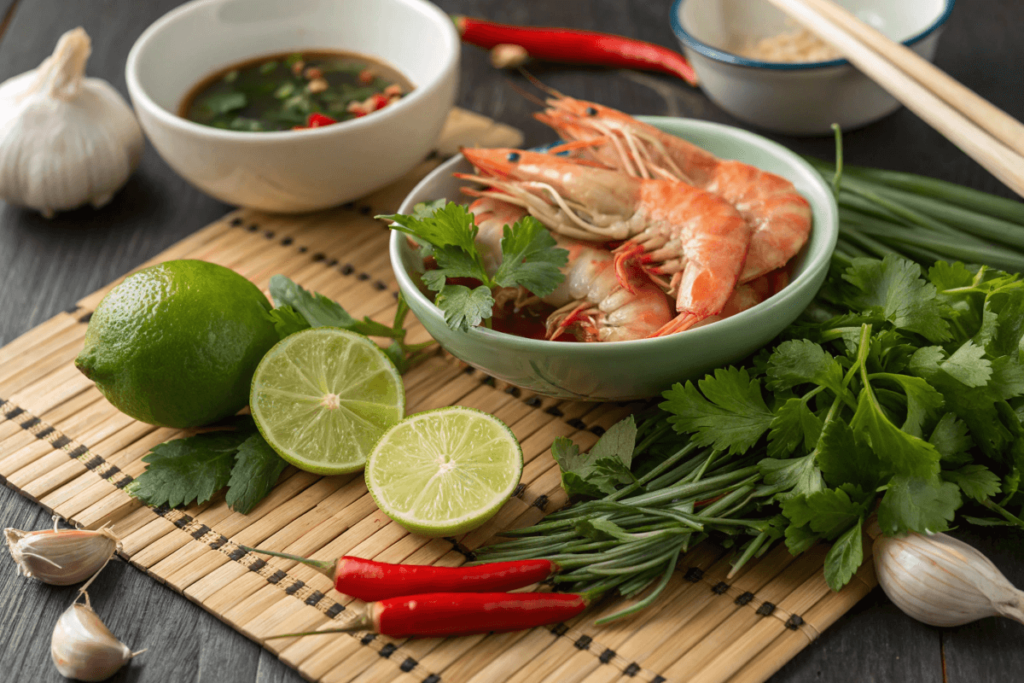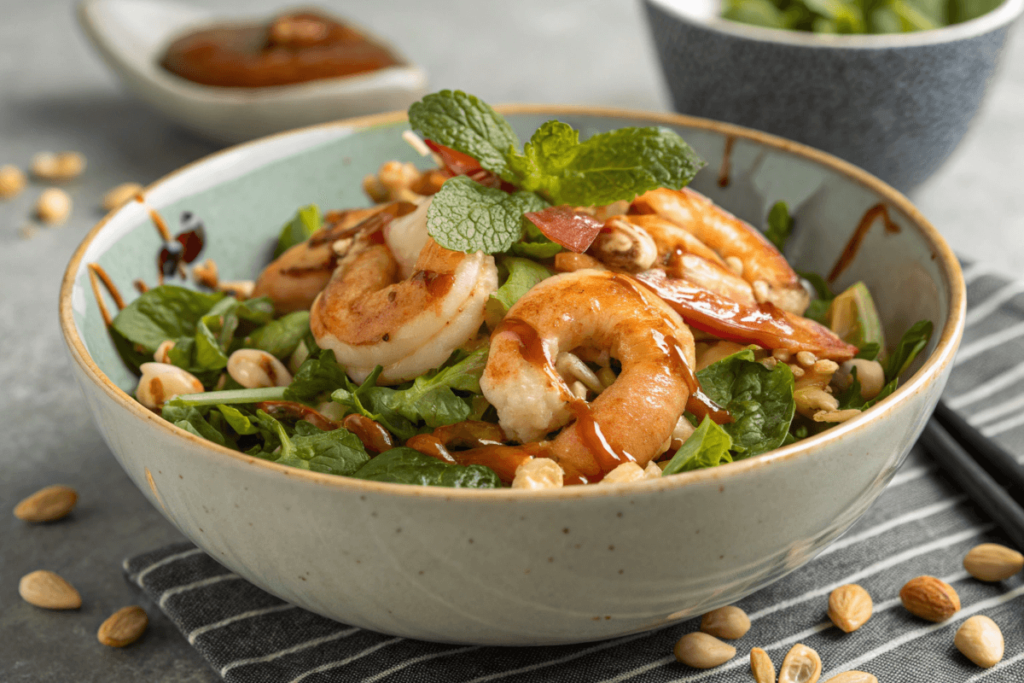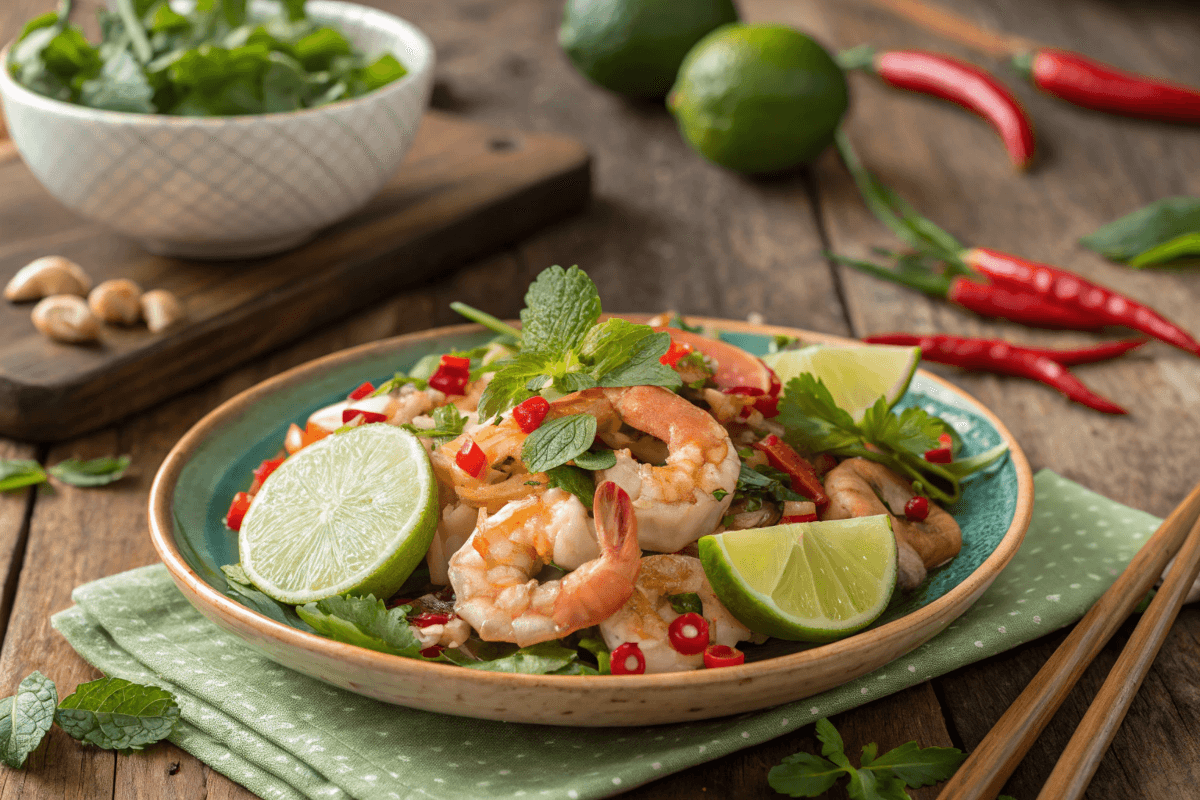What is Jumping Shrimp Salad?
Jumping Shrimp Salad, also known as Goong Ten, is a unique and lively dish from Southeast Asia, particularly popular in Thailand and Laos. This dish offers an adventurous culinary experience as it features live shrimp paired with a tangy, spicy dressing. It’s a bold choice for foodies looking to explore vibrant street food culture.
In this article, we’ll dive into the origins, cultural significance, and preparation of this fascinating dish. You’ll learn about its ingredients, variations, health aspects, and why it’s cherished by locals and travelers alike. Ready to explore one of the most thrilling delicacies in the world? Let’s jump in!
Introduction to Jumping Shrimp Salad
The Origins of Jumping Shrimp Salad
Jumping Shrimp Salad has deep roots in the street food markets of Thailand and Laos. Known locally as Goong Ten—which translates to “dancing shrimp”—this dish is celebrated for its freshness and interactive dining experience. The tradition of eating live shrimp in a spicy, citrusy dressing stems from the northeastern region of Thailand, particularly in Isaan, where food is a vibrant reflection of the local culture and environment.
This dish embodies the essence of Southeast Asian cuisine: fresh ingredients, bold flavors, and a touch of the unexpected. Unlike other shrimp dishes that rely on cooking, Jumping Shrimp Salad emphasizes rawness and natural texture, making it a daring choice for adventurous eaters.
What Makes It Unique?
The most defining feature of Jumping Shrimp Salad is, of course, its live shrimp. The shrimp are not just fresh—they’re still moving when served! When combined with lime juice, chili, and fish sauce, the shrimp seem to “jump” on your plate, creating a lively spectacle. The balance of flavors is another highlight: the dish delivers a powerful punch of heat, acidity, and umami, all in one bite.
Adding to its uniqueness, the dish is often prepared and enjoyed in bustling street markets, enhancing the overall sensory experience. The sight, sound, and aroma of fresh shrimp being tossed in a fiery dressing attract curious onlookers and eager food enthusiasts. No wonder it’s considered a must-try delicacy for those exploring Thailand’s culinary scene.
The Cultural Significance of Jumping Shrimp Salad
A Culinary Icon in Thailand and Laos
Jumping Shrimp Salad, or Goong Ten, is more than just a dish—it’s a cultural emblem in Thailand and Laos. Found predominantly in the northeastern Isaan region, this lively delicacy has roots in the vibrant street food culture that defines the region. Locals cherish this dish not only for its bold flavors but also for its connection to traditional fishing and farming practices. The use of live shrimp symbolizes freshness and a respect for nature’s bounty.
In Laos, this dish is a common offering during family gatherings and festivals, reflecting its integral role in fostering a sense of community. Sharing Jumping Shrimp Salad often sparks laughter and conversation, as diners marvel at the “dancing” shrimp. It’s a cultural experience that bridges the gap between tradition and modern street food innovation.
Traditions and Festivals Featuring the Dish
In both Thailand and Laos, festivals often spotlight this unique dish. During Songkran (Thai New Year), it’s common to see vendors preparing Goong Ten in bustling markets, surrounded by locals and tourists eager to taste the flavorful creation. Similarly, in Laos, the dish takes center stage during Boun Bang Fai, the Rocket Festival, where food and festivities unite communities.
This salad’s cultural resonance extends beyond its taste. It symbolizes a daring spirit and a willingness to embrace the unexpected, which is why it’s frequently showcased to visitors exploring the local cuisine. In short, What is jumping shrimp salad?—it’s a gateway to understanding the culinary and cultural richness of Southeast Asia.
Ingredients and Preparation
Key Ingredients in Jumping Shrimp Salad
The allure of Jumping Shrimp Salad lies in its simplicity and freshness. The dish typically includes live shrimp, lime juice, fish sauce, chili peppers, garlic, and fresh herbs like cilantro and mint. These ingredients come together to create a harmonious balance of sour, salty, spicy, and aromatic flavors.
The shrimp’s lively movement adds a unique tactile element to the dish, which distinguishes it from more conventional shrimp salads. Fresh vegetables like shredded carrots, onions, and cucumber are often added for a crisp texture and visual appeal.

Step-by-Step Preparation Process
Preparing Jumping Shrimp Salad requires precision and speed to maintain the shrimp’s vitality. Here’s how it’s typically made:
- Gather Fresh Ingredients
Ensure all components are fresh, particularly the shrimp, which should be alive for the best experience. - Prepare the Dressing
Mix lime juice, fish sauce, crushed garlic, and chopped chilies in a bowl. Adjust the chili level based on your spice tolerance. - Combine and Toss
Quickly toss the live shrimp with the dressing, ensuring they’re evenly coated. Add thinly sliced onions, carrots, and herbs for added depth. - Serve Immediately
The salad is best served fresh, capturing the full essence of its lively presentation and bold flavors.
For those new to Southeast Asian cuisine, crafting this dish at home can be an exhilarating culinary challenge. If you’re curious about alternative seafood salads, check out this Shrimp Salad Recipe for more inspiration.
The Eating Experience
Taste Profile: What to Expect
When you take your first bite of Jumping Shrimp Salad, you’re hit with a medley of bold and exciting flavors. The tangy zing of fresh lime juice, the fiery heat of chilies, and the savory depth of fish sauce combine to create a flavor explosion. It’s a delightful balance of sour, salty, and spicy, with just a hint of sweetness from the shrimp’s natural juices.
Adding to the dish’s charm is its unique texture. The shrimp, still lively when served, offer a fresh, slightly crunchy bite that contrasts beautifully with the soft herbs and crisp vegetables. It’s a sensory adventure that keeps diners coming back for more.
Why Some Find It Thrilling
The thrill of eating Jumping Shrimp Salad lies not just in its taste but in its presentation. Watching the shrimp “dance” in the tangy dressing before eating can be a little nerve-wracking yet incredibly entertaining. It’s a culinary dare that adventurous eaters often boast about.
For the less adventurous, though, the idea of consuming live shrimp might feel intimidating. But those who embrace the experience quickly realize why this dish is so beloved in Southeast Asia. It’s not just food; it’s a story, a memory, and a way to connect with a culture that values freshness and bold flavors.
Health Benefits and Concerns
Nutritional Value of Jumping Shrimp Salad
Jumping Shrimp Salad isn’t just about thrill and flavor; it’s also packed with nutrients. Shrimp are an excellent source of protein, low in fat, and rich in essential vitamins and minerals like B12, zinc, and selenium. The fresh herbs, such as cilantro and mint, provide antioxidants and other health-boosting compounds.
The dish’s use of raw, fresh ingredients means you’re getting maximum nutritional benefits. The vegetables add fiber, while the lime juice provides a healthy dose of vitamin C. All these elements make this dish a wholesome option for those seeking a protein-rich, low-calorie meal.
Health Risks: Raw and Live Ingredients
Despite its health benefits, Goong Ten comes with certain risks. Eating live shrimp can expose diners to potential bacterial infections or parasites if the seafood isn’t sourced or handled properly. This is why it’s crucial to ensure the shrimp are incredibly fresh and purchased from a reliable vendor.
Additionally, the spiciness of the dish might not suit everyone. Individuals with sensitive stomachs or those prone to acid reflux should approach with caution, as the combination of chili and lime can be quite intense.
For those hesitant to try Goong Ten due to its raw components, there are plenty of delicious cooked alternatives. For more ideas, check out our recipe article on shrimp-based dishes.
Variations and Adaptations

Regional Variations Across Southeast Asia
Though the classic version of Jumping Shrimp Salad is most commonly found in Thailand and Laos, other regions across Southeast Asia have put their unique spin on the dish. In Vietnam, for example, similar salads incorporate shrimp with an emphasis on fresh herbs like Thai basil and Vietnamese coriander. Meanwhile, in Cambodia, the dish may include roasted peanuts for an added crunch and nuttier flavor.
Even within Thailand, there are subtle differences in how the salad is prepared. Some areas use a milder chili to tone down the heat, while others include more garlic for a pungent kick. These regional tweaks make exploring the variations of Jumping Shrimp Salad a delightful journey for food enthusiasts.
Modern Twists on a Traditional Dish
In recent years, chefs worldwide have embraced Jumping Shrimp Salad, offering modern twists to cater to diverse palates. Some replace live shrimp with cooked or marinated shrimp to make the dish more approachable. Others experiment with the dressing, adding ingredients like tamarind paste or honey for a different flavor profile.
Vegan and vegetarian versions have also emerged, substituting shrimp with plant-based alternatives like tofu or jackfruit while keeping the zesty, spicy dressing intact. These adaptations allow people with dietary restrictions or preferences to enjoy the essence of the dish without compromising on flavor.
FAQs About Jumping Shrimp Salad
Is Jumping Shrimp Salad Safe to Eat?
Many wonder, What is jumping shrimp salad? and is it safe? The safety largely depends on the freshness and quality of the shrimp. When sourced from reputable vendors and handled correctly, the dish is safe to eat. However, it’s essential to check that the shrimp are alive and properly cleaned to avoid any potential health risks.
What Does Jumping Shrimp Salad Taste Like?
Jumping Shrimp Salad offers a vibrant mix of flavors—sour, spicy, salty, and slightly sweet. The lime and chili create a tangy heat that complements the freshness of the shrimp, while the fish sauce adds an umami depth. It’s a dish that surprises and delights the palate with every bite.
Where Can You Try Jumping Shrimp Salad?
This dish is a staple in Thai and Laotian street markets, particularly in the Isaan region of Thailand. Many local restaurants also offer their version of the salad. For those outside Southeast Asia, some adventurous Thai restaurants or specialty food festivals might serve this unique dish.
How Is It Different from Other Shrimp Salads?
Unlike typical shrimp salads, Jumping Shrimp Salad uses live shrimp, making it one of the most exciting dining experiences. Its bold dressing and lively presentation set it apart, offering both a visual spectacle and a burst of vibrant flavors.
Conclusion: A Thrill on Your Plate
Why Adventurous Foodies Love It
For those who seek out daring culinary adventures, Jumping Shrimp Salad offers a once-in-a-lifetime experience. It’s not just the flavors that make this dish remarkable but also its interactive nature and the sheer thrill of eating live shrimp. Every bite brings a vibrant burst of sour, spicy, and savory flavors, which is why it’s a favorite among foodies who enjoy pushing boundaries. Whether you’re exploring street markets in Thailand or dining at a local Laotian eatery, this dish guarantees a memorable culinary story to share.
Final Thoughts on Jumping Shrimp Salad
So, what is jumping shrimp salad? It’s much more than a simple shrimp dish; it’s an embodiment of Southeast Asia’s bold and lively culinary culture. The dish reflects the importance of fresh, local ingredients and the joy of sharing food with others. Whether you’re enjoying its traditional form or a modern twist, Jumping Shrimp Salad provides a unique and unforgettable dining experience that’s sure to leave a lasting impression. If you’re curious about this lively delicacy, don’t hesitate to give it a try—you might just discover your new favorite dish!
FAQs: Common Questions About Jumping Shrimp Salad
Is Jumping Shrimp Salad a Popular Dish?
Absolutely! It’s a beloved dish in Thailand and Laos, especially in regions where fresh shrimp is readily available. Tourists often seek it out to enjoy the authentic flavors of Southeast Asian cuisine.
Can You Make dancing shrimp salad at Home?
Yes, but it requires fresh, live shrimp and a knack for balancing bold flavors. If you’re feeling adventurous, follow a recipe that includes lime juice, fish sauce, chilies, and fresh herbs. Just ensure the shrimp are clean and safe to eat.
What Sets Jumping Shrimp Salad Apart from Other Thai Dishes?
Unlike many Thai dishes that rely on cooked ingredients, this salad celebrates raw, live shrimp. Its unique preparation and lively presentation make it one of the most talked-about dishes in Thai cuisine.
How Do Locals Serve Jumping Shrimp Salad?
Locals often serve it as a shared appetizer or light meal, accompanied by sticky rice or fresh vegetables. The lively presentation is a key part of the experience, sparking joy and conversation at any table.

